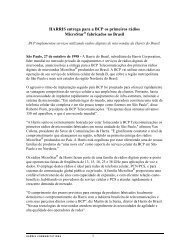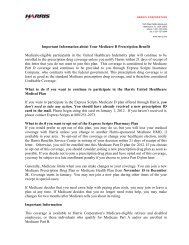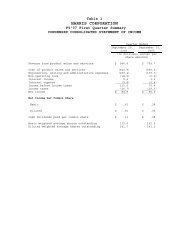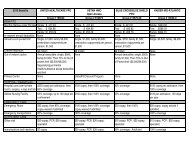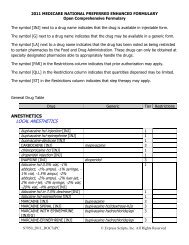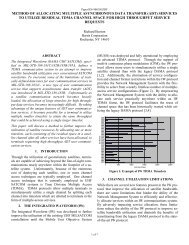harris corporation
harris corporation
harris corporation
You also want an ePaper? Increase the reach of your titles
YUMPU automatically turns print PDFs into web optimized ePapers that Google loves.
fixed price and, as a result, benefit from cost savings and carry the burden of cost overruns. Under our<br />
U.S. Government fixed-price incentive contracts, we share with the U.S. Government both savings accrued from<br />
contracts performed for less than target costs as well as costs incurred in excess of targets up to a negotiated ceiling<br />
price (which is higher than the target cost), but carry the entire burden of costs exceeding the negotiated ceiling<br />
price. Accordingly, under such incentive contracts, profit may also be adjusted up or down depending upon whether<br />
specified performance objectives are met. Under our U.S. Government firm fixed-price and fixed-price incentive<br />
contracts, we usually receive either milestone payments equaling 100 percent of the contract price or monthly<br />
progress payments from the U.S. Government in amounts equaling 80 percent of costs incurred under the contract.<br />
The remaining amounts, including profits or incentive fees, are billed upon delivery and final acceptance of end<br />
items and deliverables under the contract. Our U.S. Government fixed-price contracts generally have higher profit<br />
margins than our U.S. Government cost-reimbursable contracts. Our production contracts are mainly fixed-price<br />
contracts, and development contracts are generally cost-reimbursable contracts.<br />
As stated above, U.S. Government contracts are terminable for the convenience of the U.S. Government, as<br />
well as for default based on performance. Companies supplying goods and services to the U.S. Government are<br />
dependent on Congressional appropriations and administrative allotment of funds and may be affected by changes in<br />
U.S. Government policies resulting from various military, political, economic and international developments. Longterm<br />
U.S. Government contracts and related orders are subject to cancellation if appropriations for subsequent<br />
performance periods become unavailable. Under contracts terminable for the convenience of the U.S. Government, a<br />
contractor is entitled to receive payments for its allowable costs and, in general, the proportionate share of fees or<br />
earnings for the work done. Contracts that are terminable for default generally provide that the U.S. Government<br />
pays only for the work it has accepted and may require the contractor to pay for the incremental cost of<br />
reprocurement and may hold the contractor liable for damages. In many cases, there is also uncertainty relating to<br />
the complexity of designs, necessity for design improvements and difficulty in forecasting costs and schedules when<br />
bidding on developmental and highly sophisticated technical work. Under many U.S. Government contracts, we are<br />
required to maintain facility and personnel security clearances complying with DoD and other Federal agency<br />
requirements. For further discussion of risks relating to U.S. Government contracts, see “Item 1A. Risk Factors” and<br />
“Item 3. Legal Proceedings” of this Report.<br />
Funded and Unfunded Backlog<br />
Our total company-wide funded and unfunded backlog was approximately $7,786 million at July 1, 2011<br />
compared with approximately $6,526 million at July 2, 2010 and $6,317 million at July 3, 2009. The funded portion<br />
of this backlog was approximately $3,358 million at July 1, 2011 compared with approximately $3,250 million at<br />
July 2, 2010 and $2,315 million at July 3, 2009. The determination of backlog involves substantial estimating,<br />
particularly with respect to customer requirements contracts and development and production contracts of a costreimbursable<br />
or incentive nature.<br />
We define funded backlog as unfilled firm orders for products and services for which funding has been<br />
authorized and, in the case of U.S. Government agencies, appropriated. We define unfunded backlog as primarily<br />
unfilled firm contract value for which funding has not yet been authorized or, in the case of U.S. Government<br />
agencies, appropriated, including the value of contract options in cases of material contracts that have options we<br />
believe are probable of being exercised. We do not include potential task or delivery orders under IDIQ contracts in<br />
our backlog. In fiscal 2012, we expect to fill approximately 75 percent of our total funded backlog as of July 1,<br />
2011. However, we can give no assurance of such fulfillment or that our funded backlog will become revenue in any<br />
particular period, if at all. Backlog is subject to delivery delays and program cancellations, which are beyond our<br />
control. Additional information with regard to the backlog of each of our segments is provided under “Item 1.<br />
Business — Description of Business by Segment” of this Report.<br />
Research, Development and Engineering<br />
Research, development and engineering expenditures totaled approximately $983 million in fiscal 2011,<br />
$1,047 million in fiscal 2010 and $1,003 million in fiscal 2009. Company-sponsored research and product<br />
development costs, which included research and development for commercial products and services and independent<br />
research and development related to government products and services, as well as concept formulation studies and<br />
bid and proposal efforts, were approximately $336 million in fiscal 2011, $326 million in fiscal 2010 and<br />
$244 million in fiscal 2009. A portion of our independent research and development costs are allocated among<br />
contracts and programs in process under U.S. Government contractual arrangements. Company-sponsored research<br />
and product development costs not otherwise allocable are charged to expense when incurred. The portion of total<br />
research, development and engineering expenditures that was not company-sponsored was funded by the<br />
U.S. Government and is included in our revenue. Customer-sponsored research and development was $647 million<br />
15




